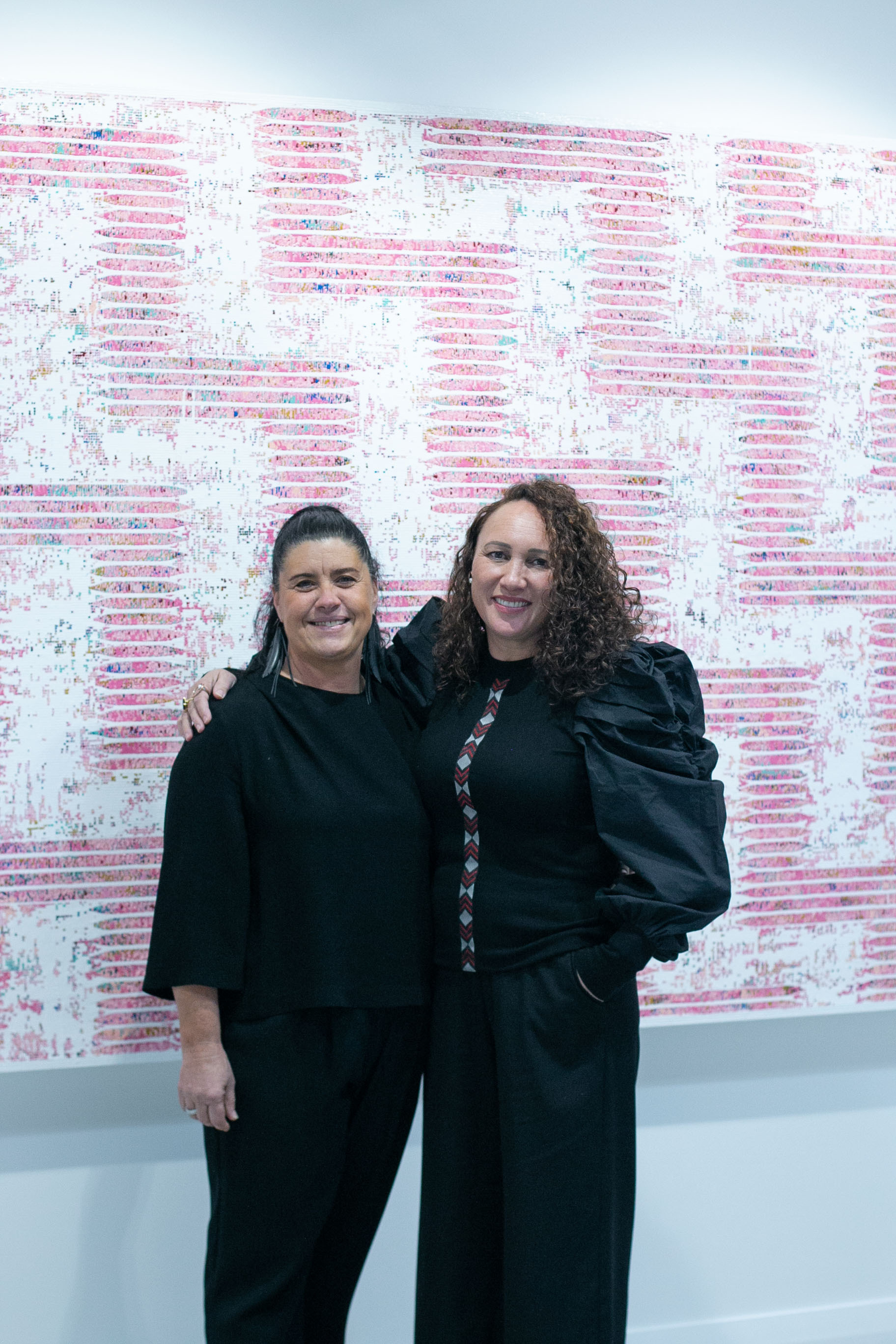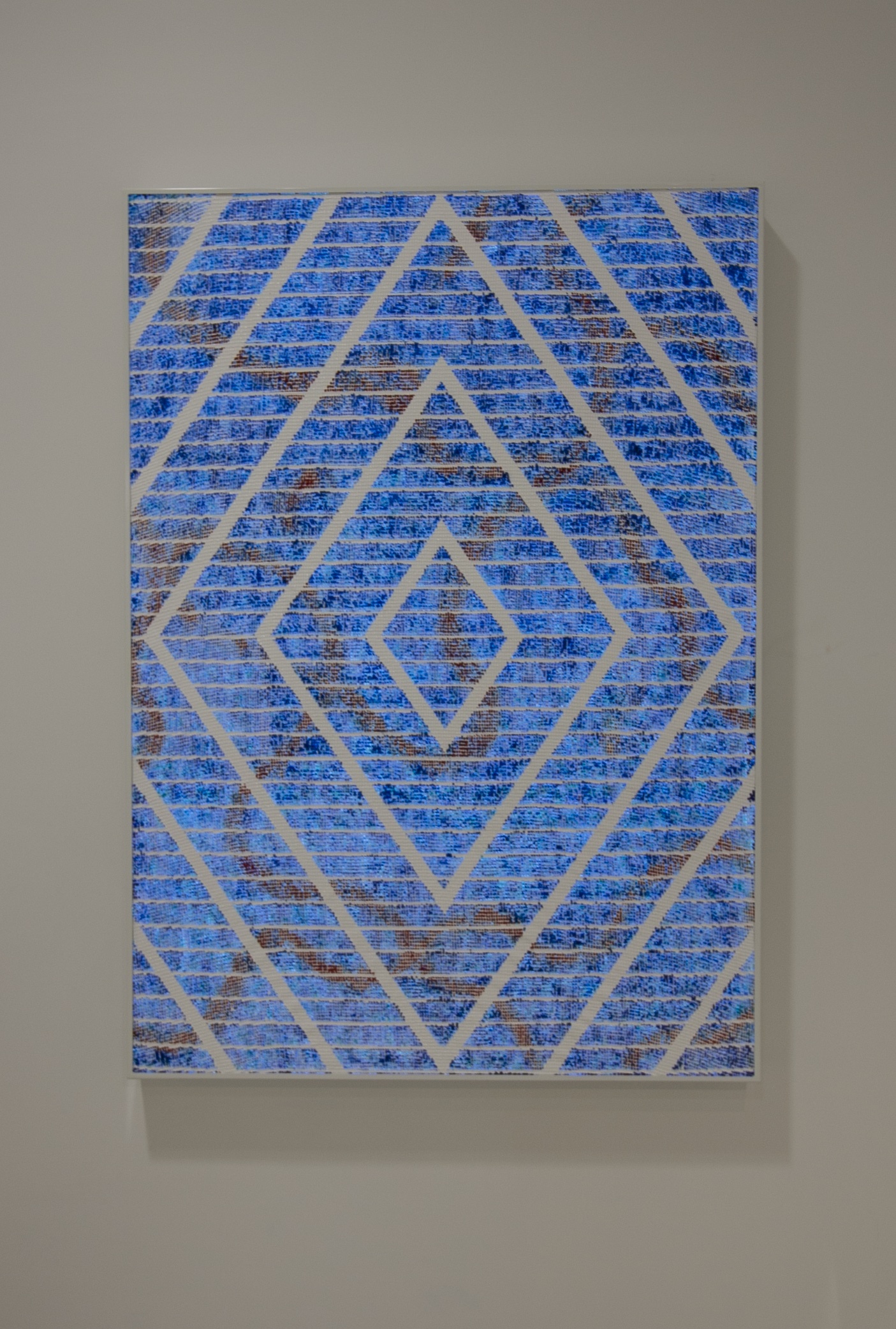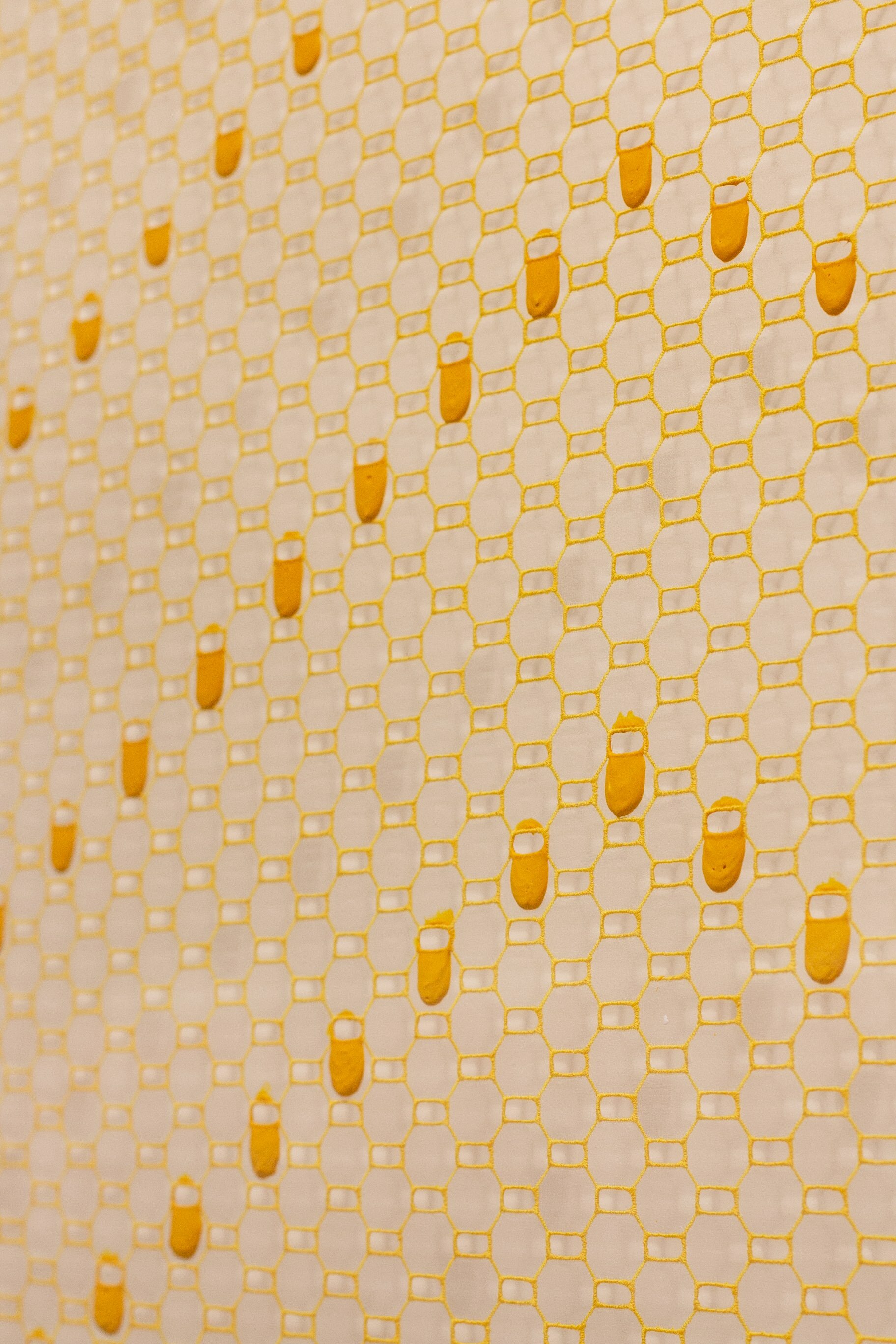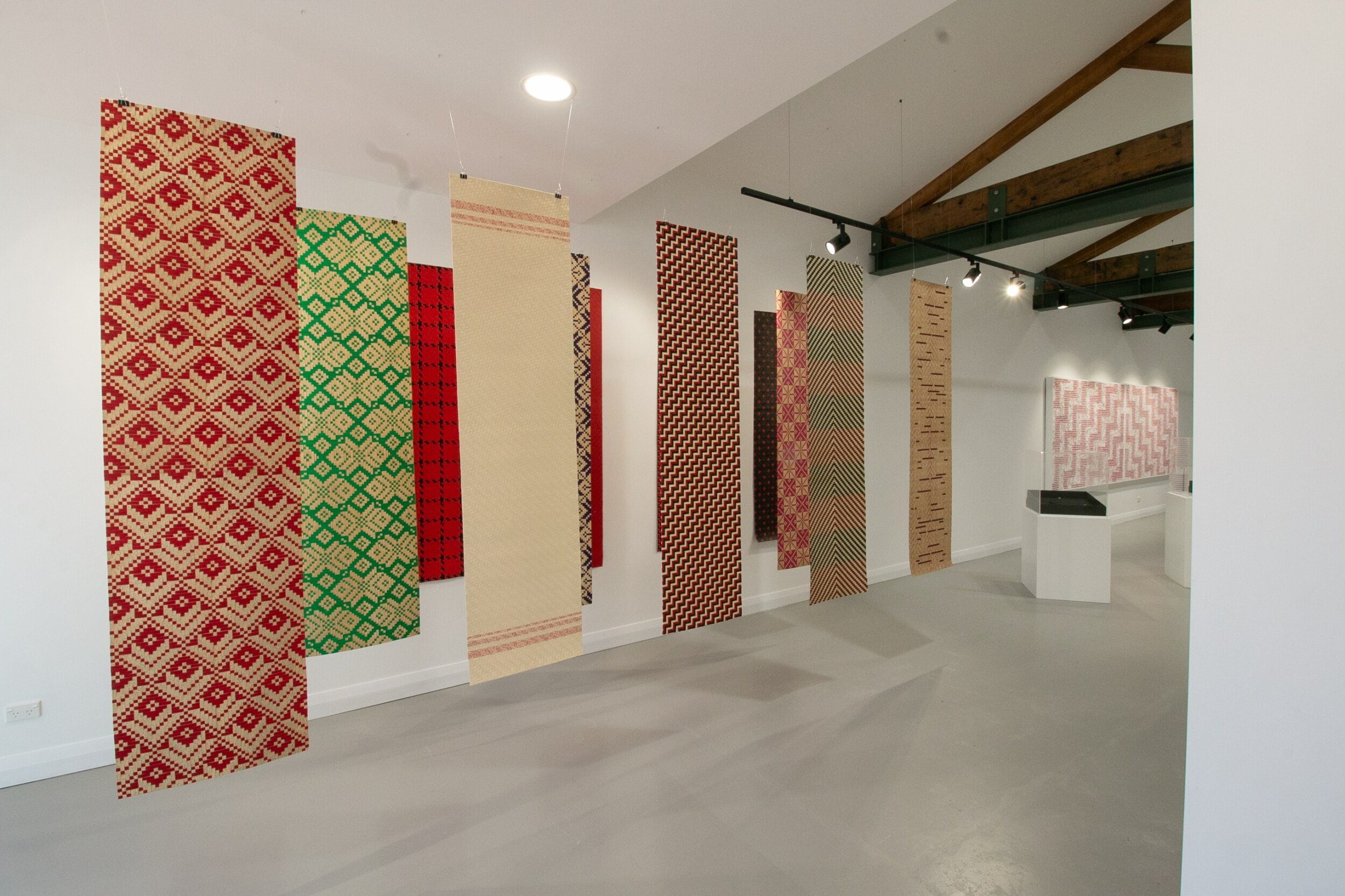

The art practices of Peata Larkin (Tūhourangi, Ngāti Whakaue, Ngāti Tūwharetoa) and Alexis Neal (Ngāti Awa/Te Ātiawa) intersect through their ancestral connections to weaving. Whaka-aho (connecting threads) is a joint exhibition of works that ignite shared conversations between the artists’ personal developments and influences, celebrating weaving structures that explore a sense of identity.
The backbone of Alexis’ practice is printmaking, incorporated with raranga (weaving), which pushes the print medium into three dimensions. Peata’s work operates in a space between binary constructions (Māori/Pākehā, past/present, art/science, matter/ spirit) and spheres of knowledge, pieced together into new, hybrid forms of painting and weaving.
Tauranga Art Gallery’s Senior Curator Serena Bentley chats to the two artists about the show:
S: How did you two meet?
A: We first meet at an opening at Corban Estate Gallery in Henderson where we were both part of a group Matariki show. Later Peata enrolled in one of my term printmaking classes at the Browne School of Art, and it was from there we started talking about collaboratively exhibiting together.
S: Raranga (weaving) is central to your work; can you elaborate on your relationship with this medium?
A: I have always been drawn to anything woven, technically always seeking out new skills, so I guess it was evitable that I started introducing a woven component into my practice. Like anyone I started with the basics, and it grew from there slowly teaching myself more advanced raranga/whatu techniques as I developed new bodies of work. It is addictive and it suits my personality, I love the repetitive nature of weaving not unlike printmaking, it seemed the perfect marriage.

P: I grew up severed from my Māori heritage as my mother who is Māori left when we were very young so we were brought up by our English father. It was a tumultuous time for me and my siblings as we didn’t seem to fit in, seemingly too brown to be Pakeha but not brown enough to be Māori and that loss of identity affected us immensely. I remember being called ‘half cast dirty arse’ a lot growing up and that really does horrible things to your sense of well-being so due to this racist environment I felt ashamed to be Māori. I didn’t have the love, support and Māoritanga to uplift me as a child, teenager or young adult. It wasn’t until I had my daughter when I was 25 years old that I felt this real urge and courage to learn more about my identity and whakapapa so I knew who I was for her and my welfare. I needed to connect many dots to feel whole. Once I started asking questions I realised the depth of identity loss felt by all my whānau and the generational trauma experienced. My Koro and nan and then my mum and her siblings weren’t allowed to speak Māori so there was a disconnect that flowed through. Having the gift of being creative was my way of working through this trauma and finding ways to express myself and find the path back to my tīpuna.
Raranga became so important to me because the more I learned about my whakapapa and our stories, the more I wanted to share that and as a painter I needed to find a creative way to not only heal but express my journey. Finding out about my whakapapa has been very hard and possibly added to the intrigue of how we as Māori pass on tribal knowledge or information and even how any information evolves over time. What stood out to me was the language of Raranga and tukutuku which was predominantly created by wahine who would tell our stories through weaving. Because I didn’t have that whānau connection to learning Raranga in traditional form, I chose to tell my personal story through my paintings and I asked permission to tell my new discoveries about our iwi in this contemporary form because I knew not only did it give me a sense of self-worth but it was also evident that there were so many more displaced Māori like me and art is a powerful way to connect and strengthen us collectively.

S: Your exhibition Whaka-aho contains works that you’ve identified as being key moments or turning points in your respective practices – can you talk us through a couple of them?
A: Yeah, there are some big statement works in this show, works that talk very much about our personal developments, shifts of direction and technical understanding, light bulb moments if you like when an artist realises a new idea and the journey that takes them on. Pivotal moments in a career where residencies have given us time to reflect and respond to an area of research. "Works can sit in my head for some time until I work out how I can execute them to the best of my ability, the delight is when the thoughts inside my head come to physical fruition".
P: Yes, all of the works in the show mark important times in my life mostly relating to new information that I learned about my tīpuna or expressions/memories of my whānau and Whenua. ‘I am Tūhourangi (Pink & white terraces)’ is a very important series. It was when I found out that my ancestors were the guardians of the pink and white terraces and lived on the shores of Lake Rotoiti and Tarawera until Mount Tarawera erupted. The pride I felt was immense but there was this deep sadness too. Many lives were lost and my iwi were forced to find new homes. They settled in Whakarewarewa and Ngapuna. I created mine and their story in Poutama form as it symbolises the ‘stairway to heaven’ which some believed Tawhāki climbed to obtain the 3 kete of knowledge but simultaneously acknowledges the strength of our tīpuna and their survival, be it an eruption or colonisation. It also references art historical elements such as geometric abstraction, the grid and the history of the jacquard loom, the precursor to the first computer and man-made tapestries. I love playing with multifaceted ideas and embedding them in my creations. The other work worth mentioning is the small lightbox ‘Hiwa-i-te-rangi’ that I was determined to finish for Whaka-aho. Man that was a meant-to-be piece for a few reasons. I was actually trying to finish ‘Matariki’ lightbox but it wasn’t working and so I thought I’d leave it and just had this strong urge to finish ‘Hiwa-i-te-rangi’. This flowed so easily and even sorting the technical issues of the frame etc just fell into place. ‘Hiwa-i-te-rangi represents our aspirations for a prosperous season ahead (Matamua, 2017). She is connected to looking forward: planning to succeed, hopes for future growth, and holding on to a prosperous vision of our future.’ So to have this artwork featured in this exhibition truly cemented one of my dreams to exhibit in Tauranga…to top it off, I went to Ron Te kawa’s exhibition and it said in his statement that his creation of Hiwa-i-te-rangi wasn't able to be exhibited in her full form due to being damaged in the floods. I got the shivers as she was the only one I could include so it was lovely to have her there in some form and the fact she embraces our aspirations is pretty cool. Moments give me the warm fuzzies and cement those meant-to-be moments.

S: There’s a real intimacy to this show, your friendship is palpable; how does your collaboration work?
A: Very early on in our friendship we both identified similar focuses and ideas, both motivated by upskilling and reinventing our practices, supported by our conceptual ideas. We are not working in the same studio space, but we talk regularly, we knew there was a lovely conversation to be had between our works. Who knows, it may develop into more collaborative pieces or installations in the future.
P: I felt an instant connection to Alexis as a person and to her mahi. She has become an important part of my life and exhibiting with her has been a beautiful thing. We both experienced disconnect from our Māori heritage growing up and fortifying our bloodlines are an important element of our mahi and whilst we work in very different mediums the mauri or life force of our practices and our personal stories/aesthetics harmonise.

S: Whaka-aho is a new incarnation of Whakamata, originally shown at Mangere Art Centre last year – how does it feel to realise this version in Tauranga Moana and what is unique about Whaka-aho in comparison?
A: It was an interesting process selecting these key pieces for this new iteration, they feel like 'pou pieces' the pieces that hold everything up.
P: Whakamata was at Mangere Arts Centre in Tāmaki Makaurau, which is quite a large minimal space. We were able to include over 40 of our artworks and planned it out before we started the installation. The new Tauranga Art Gallery Pop Up space was very different in terms of size and shape with obvious rafters plus the lighting, so we needed to take this into consideration when choosing the works for Whaka-aho. We had to pare back on the original exhibition in Mangere which was hard to do. There were anchor works that we knew needed to be included and chose our works from there. Whakamata is the first foundational row when weaving a cloak. Alexis and I wanted to emphasise the metaphorical connotations to this in how we established our practices so we included a timeline of early to present works, but it also refers to our journey to our Māori roots. Whaka-aho or connecting threads was the next step in our journey as the show not only does it talk about the continuum of our practices but also exhibiting together/touring our mahi.
Whaka-aho, supported by Holland Beckett Law, is showing at the new Tauranga Art Gallery POP UP (42-44 Devonport Road) until 1 October 2023.
Copyright © 2016 - 2024 Tauranga Art Gallery. All rights reserved. Privacy | Sitemap | Website by MOCA